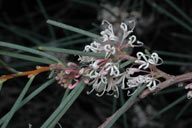In Flower This Week
A weekly news sheet prepared by a Gardens' volunteer.
Numbers before each plant refer to temporary IFTW labels in the gardens.
Numbers in square brackets [ ] refer to garden bed Sections. Plants in flower are in bold type.
View past issues of 'In Flower This Week'.
30 April 2014
Hakea cycloptera click for larger image |
We will walk part of the Main Path today, starting with the attractive pots at the Visitor Information Centre (VIC).
- Notice at the front of the VIC a pot of Hemiandra pungens [Section 221], commonly known as Snakebush, a trailing plant with bright green leaves and mauve tubular flowers which is endemic to south-western Western Australia where it grows on rocky outcrops.
- Also near the door is a pot of Lechenaultia formosa [Section 221], which is a small attractive plant with close grey-green foliage and bright red flowers with orange centres. The genus Lechenaultia is named after Leschenault de la Tour, naturalist on a French expedition that visited Australia between 1801 and 1803.
- Further along on your right is Epacris impressa [Section 174], a straggly bush with bright pink tubular flowers. The form seen here is often referred to as Pink Heath, and is the floral emblem of the state of Victoria.
- Prostanthera phylicifolia [Section 210], or Spiked Mint-bush, has masses of small mauve flowers on a lax bush which scrambles down a bank.
- Cross the bridge and continue around the side of the café to see on your left Epacris longiflora ‘Nectar Pink’ [Section 131], which is a very floriferous small shrub covered in slender pink bells with white tips.
- On your right is Correa reflexa (Kangaroo Island form) [Section 240], a long-flowering small shrub with neat foliage and pink tubular flowers with green tips and exserted (protruding) stamens.
- Also on your right Acacia alata var. biglandulosa [Section 240] with flattened phyllodes and masses of white fluffy ball flowers.
- Go up the hill to see on the right hand side Thryptomene denticulata [Section 11], which has tiny pink flowers on a small bush with arching foliage. In the wild this species is confined to western parts of Western Australia, in the Irwin District.
- In a pot on your left is Grevillea saccata [Section 30] a shrub with terminal clusters of reddish‑orange flowers that have prominent yellow pouches housing the anthers. This feature is referenced in the common name Pouched Grevillea. The species is endemic to south-western Western Australia.
- On your left is Callistemon ‘Reeve’s Pink’ [Section 30], a medium bush with bright pink brush-like flowers much loved by bees. It originated as a chance seedling at the nursery of Mr Reeve Snr. at Cheltenham, Victoria and was discovered there by Mr G.Wilson in 1957/58.
- Cross the road to see on your left Hakea cycloptera [Section 24], or Elm-seed Hakea, with pale pink curled flowers on spiky needle-like foliage. It is native to South Australia. The scientific name means “circular wings”, referring to the wing that surrounds the seed.
- On your right is the unusual Grevillea centristigma [Section 26], a small bush with soft lush foliage fringed with white hairs. Small hard yellow flowers open from greenish buds. It is endemic to the south west region of Western Australia.
- On your right is Grevillea baueri [Section 26], a low bush with close shiny green foliage and small red/cream flowers that is endemic to the coastal ranges of south-eastern New South Wales.
- Adenanthos sericeus [Section 26] on the right has silky grey-green foliage and small orange/red flowers. Stroke the foliage to appreciate its marvellous texture.
- On your right is Hakea clavata [Section 26]. It is a straggly bush with stiff prickly foliage and strongly-scented pink and white curled flowers.
Rosalind Walcott
![Director of National Parks [logo]](../../../../images/dnp_90px.gif)







